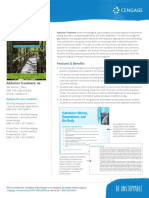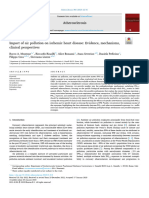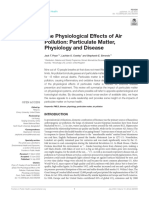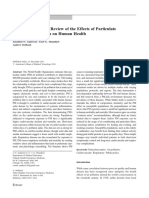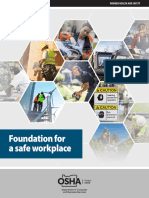Air Pollution and Cardiovascular Disease Onset: Hours, Days, or Years?
Air Pollution and Cardiovascular Disease Onset: Hours, Days, or Years?
Uploaded by
franciel.maria01987Copyright:
Available Formats
Air Pollution and Cardiovascular Disease Onset: Hours, Days, or Years?
Air Pollution and Cardiovascular Disease Onset: Hours, Days, or Years?
Uploaded by
franciel.maria01987Original Title
Copyright
Available Formats
Share this document
Did you find this document useful?
Is this content inappropriate?
Copyright:
Available Formats
Air Pollution and Cardiovascular Disease Onset: Hours, Days, or Years?
Air Pollution and Cardiovascular Disease Onset: Hours, Days, or Years?
Uploaded by
franciel.maria01987Copyright:
Available Formats
Comment
Air pollution and cardiovascular disease onset: hours, days,
or years?
Before the advent of exposure assessment tools for Although the global impact of air pollution is clear, See Articles page e932
particles and component pollutants, such as particulate operationally, questions remain on how policy makers
matter (PM) or total suspended particles, investigators should prioritise public health efforts and which
relied on counting the number of excess deaths before sensitive groups should be targeted for intervention
and after episodes of smog to draw inferences. The most efforts. In The Lancet Public Health, Andrew Fu Wah
well known historical event is the great smog of London Ho and colleagues9 report their findings on air quality
in 1952, during which a combination of cold weather, and the risk of out-of-hospital cardiac arrest (OHCA)
low-quality household coal, and factory emissions in Singapore using a time series analysis. Ho and
resulted in thousands of excess deaths attributable to colleagues analysed 18 131 OHCA cases (from hospital
severe air pollution. This event was widely considered a and ambulance service records between 2010 and 2018)
catalyst for the field of environmental epidemiology and with a median age of 65 years (IQR 56–80), of which
led to several time series analyses on air pollution-related 6484 (35·8%) were in females and 11 647 (64·2%)
morbidity and mortality,1 but a large prospective study were in males. They used multivariable fractional
was still needed to infer causality.2 In 1994, the Six Cities modelling of OHCA excess risk associated with exposure
Studies published data from a longitudinal study with to PM2·5, PM with a diameter of less than 10 μm (PM10),
more than a decade of follow-up showing that residents ozone (O3), carbon monoxide (CO), nitrogen dioxide
living in cities with more pollution had higher mortality (NO2), and sulphur dioxide (SO2). Ho and colleagues
rates than did residents living in cities with less pollution.3 found that increases in PM2·5 concentrations were
Increasing evidence led WHO to adopt a landmark associated with an acute increase in OHCAs in the
resolution in 2015 on air quality and health, recognising 2 days after exposure, with a decrease in risk over
air pollution as a risk factor for premature mortality, the subsequent 3 days, which the authors hypothesised
ischaemic heart disease, stroke, chronic obstructive to be due to a harvesting effect.9
pulmonary disease, asthma, and cancer. In 2021, WHO Singapore is an advanced economy with a high
updated the Air Quality Guidelines to lower the exposure human development index. Air pollution concen
recommendation for PM with a diameter of less than tration, while heterogenous in the study, is generally
2·5 μm (PM2·5) from 10 μg/m³ to 5 μg/m³ for annual low compared with other populous places. This study
exposure, and to advise that 24-h exposure should not contributed several key pieces of evidence. First, even
exceed 15 μg/m³ on more than 3–4 days in a year.4 at low levels of air pollution exposure, increases in
Exposure to air pollution increases the risk of PM concentrations are still associated with increased
myocardial infarction, stroke, heart failure, arrhythmia, risk of OHCA. In hypothetical modelling, Ho and
and sudden death onset by approximately 1–2% per colleagues estimated that a 1 μg/m³ reduction in
10 μg/m³ increase in concentration of PM2·5, and long- PM2·5 concentrations would reduce the number of OHCA
term exposure is associated with a 5–10% increased events by 8%, and a reduction of 3 μg/m³ would reduce
risk.5,6 Because the cardiopulmonary organs are the first the number of OHCA events by 30%, indicating large
line of contact with air pollutants, particle inhalation can relative effects in the control of PM2·5 concentrations on
elicit immediate oxidative stress, followed by chronic benefits to cardiovascular health. Second, this research
inflammatory responses that reach the circulatory provided real-world evidence on the different types and
system and its vasculatures and can affect all organ locations of cardiac arrest events. PM2·5 concentrations
systems. The American Heart Association, European affected non-shockable OHCA events, and had less
Society of Cardiology, Chinese Center for Disease Control of an effect on shockable OHCA events, the cause of
and Prevention, and national academies from many which is still to be explored. Finally, the investigators
countries have recognised air pollution as a major risk found the effects of increasing PM2·5 concentrations
factor for cardiopulmonary disease.7,8 were the largest in the immediate 2 days after exposure,
www.thelancet.com/public-health Vol 7 November 2022 e890
Comment
indicating an acute manifestation of OHCA due to air Future clinical guidelines should include air pollution
pollution. screening and ways to alert patients and providers
Both exposure windows of PM2·5, before cardiovascular ahead of a pollution event, thereby preventing medical
disease onset and time to onset after exposure, are emergencies.
informative to clinicians and patients. A recent study10 I declare no competing interests.
found that air pollution could trigger acute coronary Copyright © 2022 The Author(s). Published by Elsevier Ltd. This is an Open
Access article under the CC BY 4.0 license.
syndrome within 1 h of exposure, resulting in a heart
attack or unstable angina. John S Ji
johnji@tsinghua.edu.cn
Unanswered questions still remain. First, most air
Vanke School of Public Health, Tsinghua University, Beijing 100084, China
pollution is reported as daily or annual averages, which
1 Bell ML, Davis DL. Reassessment of the lethal London fog of 1952: novel
can mask information on amplitudes of exposure level. indicators of acute and chronic consequences of acute exposure to air
pollution. Environ Health Perspect 2001; 109 (suppl 3): 389–94.
Is the peak exposure or the cumulative average exposure
2 Dab W, Ségala C, Dor F, et al. Air pollution and health: correlation or
most predictive of health outcomes? Particularly in causality? The case of the relationship between exposure to particles and
cardiopulmonary mortality. J Air Waste Manag Assoc 2001; 51: 220–35.
the case of cardiovascular events, is the strongest risk 3 Dockery DW, Pope CA 3rd, Xu X, et al. An association between air pollution
within the first hour of exposure, over the course of and mortality in six U.S. cities. N Engl J Med 1993; 329: 1753–59.
4 WHO. WHO global air quality guidelines: particulate matter (PM2·5 and PM10),
the day, or within a few days? Second, how do single ozone, nitrogen dioxide, sulfur dioxide and carbon monoxide. World Health
pollutants or mixtures of pollutants affect outcomes? Organization, 2021. https://apps.who.int/iris/handle/10665/345329
(assessed Sept 23, 2022).
Air pollutant mixtures vary a great deal globally due to 5 Bourdel T, Bind M-A, Béjot Y, Morel O, Argacha J-F. Cardiovascular effects of
different emission sources, and particulate pollutants air pollution. Arch Cardiovasc Dis 2017; 110: 634–42.
6 Brook RD, Franklin B, Cascio W, et al. Air pollution and cardiovascular
co-occur with gaseous pollutants, which might explain disease: a statement for healthcare professionals from the Expert Panel on
Population and Prevention Science of the American Heart Association.
non-uniform concentration–response associations in Circulation 2004; 109: 2655–71.
different locations. Third, in an increasingly mobile 7 Brauer M, Casadei B, Harrington RA, Kovacs R, Sliwa K. Taking a stand
against air pollution-the impact on cardiovascular disease: a joint opinion
world, creating visualisations of air pollution spatial and from the World Heart Federation, American College of Cardiology,
temporal variability in different microenvironments American Heart Association, and the European Society of Cardiology.
Circulation 2021; 143: e800–04.
is an opportunity to involve new health surveillance 8 Expert Consensus Task Force, Shi X, Duan G. Recommendations of
and sensing technologies.6 Precision medicine can controlling and preventing acute health risks of fine particulate matter
pollution—China, 2021. China CDC Wkly 2022; 4: 329–41.
benefit from environmental surveillance data on 9 Ho AFW, Ho JSY, Tan BY-Q, et al. Air quality and the risk of out-of-hospital
cardiac arrest in Singapore (PAROS): a time series analysis.
duration of exposure, severity of exposure, timing of Lancet Public Health 2022; 7: e932–41.
exposure, coexposures, and location of exposure to 10 Chen R, Jiang Y, Hu J, et al. Hourly air pollutants and acute coronary
syndrome onset in 1.29 million patients. Circulation 2022; 145: 1749–60.
forecast cardiac arrest onset in low timelapse intervals.
e891 www.thelancet.com/public-health Vol 7 November 2022
You might also like
- Addiction Treatment: A Strengths Perspective33% (6)Addiction Treatment: A Strengths Perspective2 pages
- Prescription Privileges For Psychologists PDFNo ratings yetPrescription Privileges For Psychologists PDF16 pages
- kulick-et-al-2022-ambient-air-pollution-and-stroke-an-updated-reviewNo ratings yetkulick-et-al-2022-ambient-air-pollution-and-stroke-an-updated-review12 pages
- Fine Particle Environmental Pollution and Cardiovascular DiseasesNo ratings yetFine Particle Environmental Pollution and Cardiovascular Diseases5 pages
- Taking A Stand Against Air Pollution - The Impact On Cardiovascular DiseaseNo ratings yetTaking A Stand Against Air Pollution - The Impact On Cardiovascular Disease6 pages
- Contribution of Air Pollution To COPD and Small Airway DysfunctionNo ratings yetContribution of Air Pollution To COPD and Small Airway Dysfunction8 pages
- Epidemiological Time Series Studies of PM and Daily Mortality and Hospital Admissions: A Systematic Review and Meta-AnalysisNo ratings yetEpidemiological Time Series Studies of PM and Daily Mortality and Hospital Admissions: A Systematic Review and Meta-Analysis6 pages
- Clearing The Air: A Review of The Effects of Particulate Matter Air Pollution On Human HealthNo ratings yetClearing The Air: A Review of The Effects of Particulate Matter Air Pollution On Human Health10 pages
- Pollution and Respiratory Disease: Can Diet or Supplements Help? A ReviewNo ratings yetPollution and Respiratory Disease: Can Diet or Supplements Help? A Review14 pages
- Association Between Air Pollution Exposure and Mental Health Service Use Among Individuals With First Presentations of Psychotic and Mood Disorders Retrospective Cohort StudyNo ratings yetAssociation Between Air Pollution Exposure and Mental Health Service Use Among Individuals With First Presentations of Psychotic and Mood Disorders Retrospective Cohort Study8 pages
- Allergy 2022 Goshua - World Health Organization global air quality guideline recommendations Executive summaryNo ratings yetAllergy 2022 Goshua - World Health Organization global air quality guideline recommendations Executive summary6 pages
- Environmental Determinants of Cardiovascular Disease: Lessons Learned From Air PollutionNo ratings yetEnvironmental Determinants of Cardiovascular Disease: Lessons Learned From Air Pollution40 pages
- Low Emission Zones and Population HealthNo ratings yetLow Emission Zones and Population Health25 pages
- Review Epidemiological Basis For Particulate Air Pollution Health StandardsNo ratings yetReview Epidemiological Basis For Particulate Air Pollution Health Standards12 pages
- Public-Health Impact of Outdoor and Traffic-Related Air Pollution: A European AssessmentNo ratings yetPublic-Health Impact of Outdoor and Traffic-Related Air Pollution: A European Assessment7 pages
- A Review by The Forum of International Respiratory SocietiesEnvironmental Committee, Part 1No ratings yetA Review by The Forum of International Respiratory SocietiesEnvironmental Committee, Part 18 pages
- Impact of Coronavirus On Air Quality: Benefits Over Harm?No ratings yetImpact of Coronavirus On Air Quality: Benefits Over Harm?9 pages
- Rajagopalan Et Al 2018 Air Pollution and Cardiovascular DiseaseNo ratings yetRajagopalan Et Al 2018 Air Pollution and Cardiovascular Disease17 pages
- Air Pollution and Human Health: CommentaryNo ratings yetAir Pollution and Human Health: Commentary3 pages
- Migraine and Air Pollution A Systematic ReviewNo ratings yetMigraine and Air Pollution A Systematic Review17 pages
- Ezati 2002 - Review - The Health Impacts of Exposure To Indoor Air Pollution From Solid Fuels inNo ratings yetEzati 2002 - Review - The Health Impacts of Exposure To Indoor Air Pollution From Solid Fuels in12 pages
- Journal of Toxicology - 2012 - Genc - The Adverse Effects of Air Pollution On The Nervous SystemNo ratings yetJournal of Toxicology - 2012 - Genc - The Adverse Effects of Air Pollution On The Nervous System23 pages
- Mortality and Air Pollution in London: A Time Series AnalysisNo ratings yetMortality and Air Pollution in London: A Time Series Analysis10 pages
- Urban Air Quality and Health - Two Steps Forward, One Step Back 2019No ratings yetUrban Air Quality and Health - Two Steps Forward, One Step Back 20193 pages
- Mental Health Coorelation Due To Increase in Ambient NO2No ratings yetMental Health Coorelation Due To Increase in Ambient NO219 pages
- Emergency Hospital Admissions For Cardiovascular Diseases and Ambient Levels of Carbon MonoxideNo ratings yetEmergency Hospital Admissions For Cardiovascular Diseases and Ambient Levels of Carbon Monoxide7 pages
- The Impact of Air Pollution On Respiratory Diseases in An Era of Climate ChangeNo ratings yetThe Impact of Air Pollution On Respiratory Diseases in An Era of Climate Change5 pages
- (Barely)-living-in-smog--China-and-air-pollution_lNo ratings yet(Barely)-living-in-smog--China-and-air-pollution_l1 page
- Environmental Research: Jimyung Park, Hyung-Jun Kim, Chang-Hoon Lee, Chang Hyun Lee, Hyun Woo LeeNo ratings yetEnvironmental Research: Jimyung Park, Hyung-Jun Kim, Chang-Hoon Lee, Chang Hyun Lee, Hyun Woo Lee8 pages
- Air Particulate Matter and Cardiovascular Disease: The Epidemiological, Biomedical and Clinical EvidenceNo ratings yetAir Particulate Matter and Cardiovascular Disease: The Epidemiological, Biomedical and Clinical Evidence12 pages
- Pediatric Pulmonology - 2024 - Varghese - Outdoor Air Pollution and Near Fatal Fatal Asthma Attacks in Children ANo ratings yetPediatric Pulmonology - 2024 - Varghese - Outdoor Air Pollution and Near Fatal Fatal Asthma Attacks in Children A11 pages
- Road-Tunnels TP03 Health Effects of Traffic Related Air PollutionNo ratings yetRoad-Tunnels TP03 Health Effects of Traffic Related Air Pollution8 pages
- Air Pollution and Cardiovascular Injury: Epidemiology, Toxicology, and MechanismsNo ratings yetAir Pollution and Cardiovascular Injury: Epidemiology, Toxicology, and Mechanisms8 pages
- Respirology - 2012 - SIERRA VARGAS - Air Pollution Impact and PreventionNo ratings yetRespirology - 2012 - SIERRA VARGAS - Air Pollution Impact and Prevention8 pages
- Clearing the Air: PM2.5, Health, and the Fight Against Pollution: A Deep Dive into the Impact of Air Pollution on Human Well-being and Global Efforts to Breathe EasyFrom EverandClearing the Air: PM2.5, Health, and the Fight Against Pollution: A Deep Dive into the Impact of Air Pollution on Human Well-being and Global Efforts to Breathe EasyNo ratings yet
- Orthopedic Massage Theory and Technique 2nd ed Edition Whitney Lowe 2024 Scribd Download100% (6)Orthopedic Massage Theory and Technique 2nd ed Edition Whitney Lowe 2024 Scribd Download71 pages
- Moral Reason For Managing Health and Safety ASSIGNMENTNo ratings yetMoral Reason For Managing Health and Safety ASSIGNMENT2 pages
- 036 Sera Con P - AB - MSDS - E - 270916No ratings yet036 Sera Con P - AB - MSDS - E - 27091610 pages
- Q2nsed22 - Sto - Domingo - 300814 - Julia Ortiz Luis National High School - nsed-Form-2nd-QuarterNo ratings yetQ2nsed22 - Sto - Domingo - 300814 - Julia Ortiz Luis National High School - nsed-Form-2nd-Quarter3 pages
- Risk Assessing in Sport: Plan and Review A Safe Sporting Activity Assignment 3No ratings yetRisk Assessing in Sport: Plan and Review A Safe Sporting Activity Assignment 315 pages
- Bacterial Surface Contamination of Emergency in Ambulance During Patient ServiceNo ratings yetBacterial Surface Contamination of Emergency in Ambulance During Patient Service7 pages
- The 24 Romanian National Conference of Paediatric Haematology and OncologyNo ratings yetThe 24 Romanian National Conference of Paediatric Haematology and Oncology10 pages
- Assessment of Suicidal Intention The Scale of SuicNo ratings yetAssessment of Suicidal Intention The Scale of Suic11 pages
